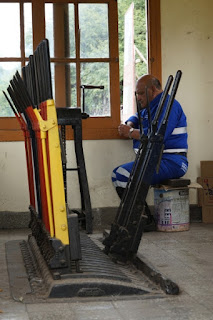The most famous
cemetery in Buenos Aires is the one of La Recoleta. This cemetery in
the rich neighborhood of Recoleta was found in 1722 using the gardens
of a disbanded convent.
The cemetery
contains 4691 vaults. 94 were declared national monuments. Burried
here are Evita Peron, several argentine presidents or dictators like
Mitre, Sarmiento and Roca, Nobel prize winners like Leloir
(chemistry), generals, artists and actors.
Like the
neighborhood around it, it is a popular tourist destination, in
particular the otherwise unspectecular grave of Eva Peron in a side
alley which is too narrow for the number of her admirers.
The graves of these
celebrities are well maintained while some of the other vaults have
fallen into disrepair. Probably people cannot afford the price of
many ten thousands of dollars for a tomb here. The cemetery might be
one of the most beautiful in the world with respect of the beauty of
its buildings, but it is definitely not representative of Buenos
Aires or Argentina. It is a place for the rich and famous, the others
are buried elsewhere.
The other big
cemetery is La Chacarita. Like Recoleta it has got the big artistic
vaults, memorials and celebrities, in particular many artists like
the tango singer Gardel.
It was found in consequence of a yellow fever epidemic when the other cemeteries did not have more capacity. In fact the posh Recoleta cemetery refused to take victims of the epidemic. Special sections are reserved for the british and german community. The german section contains the graves of Hans Langsdorff (1894–1939), Captain of the World War II battleship Admiral Graf Spree who sank his ship in the port of Buenos Aires to avoid being captured by the British, and Friedrich Bergius, who received the nobel price in chemistry in 1931.
It was found in consequence of a yellow fever epidemic when the other cemeteries did not have more capacity. In fact the posh Recoleta cemetery refused to take victims of the epidemic. Special sections are reserved for the british and german community. The german section contains the graves of Hans Langsdorff (1894–1939), Captain of the World War II battleship Admiral Graf Spree who sank his ship in the port of Buenos Aires to avoid being captured by the British, and Friedrich Bergius, who received the nobel price in chemistry in 1931.
However, the biggest
part are the endless rows of burial chambers. The older ones are
above ground. A lot of them are broken and in some you can detect
bones and skulls behind the fragments of the front plate.
The newer ones are
in endless rows of subterranean tunnels. Some have plastic or real
flowers, but save their photographs most of the occupants seem to be
forgotten.
Beyond there is a
big yard of even poorer gravesites. Wooden crosses, some flowers,
overgrown with weeds. Some parts are abandoned, the cover is broken,
most of the graves not recognisable any more. This is more like a
representation of Buenos Aires, with its small community of immensely
rich families and endless barrios of unknown poor or old people.













































